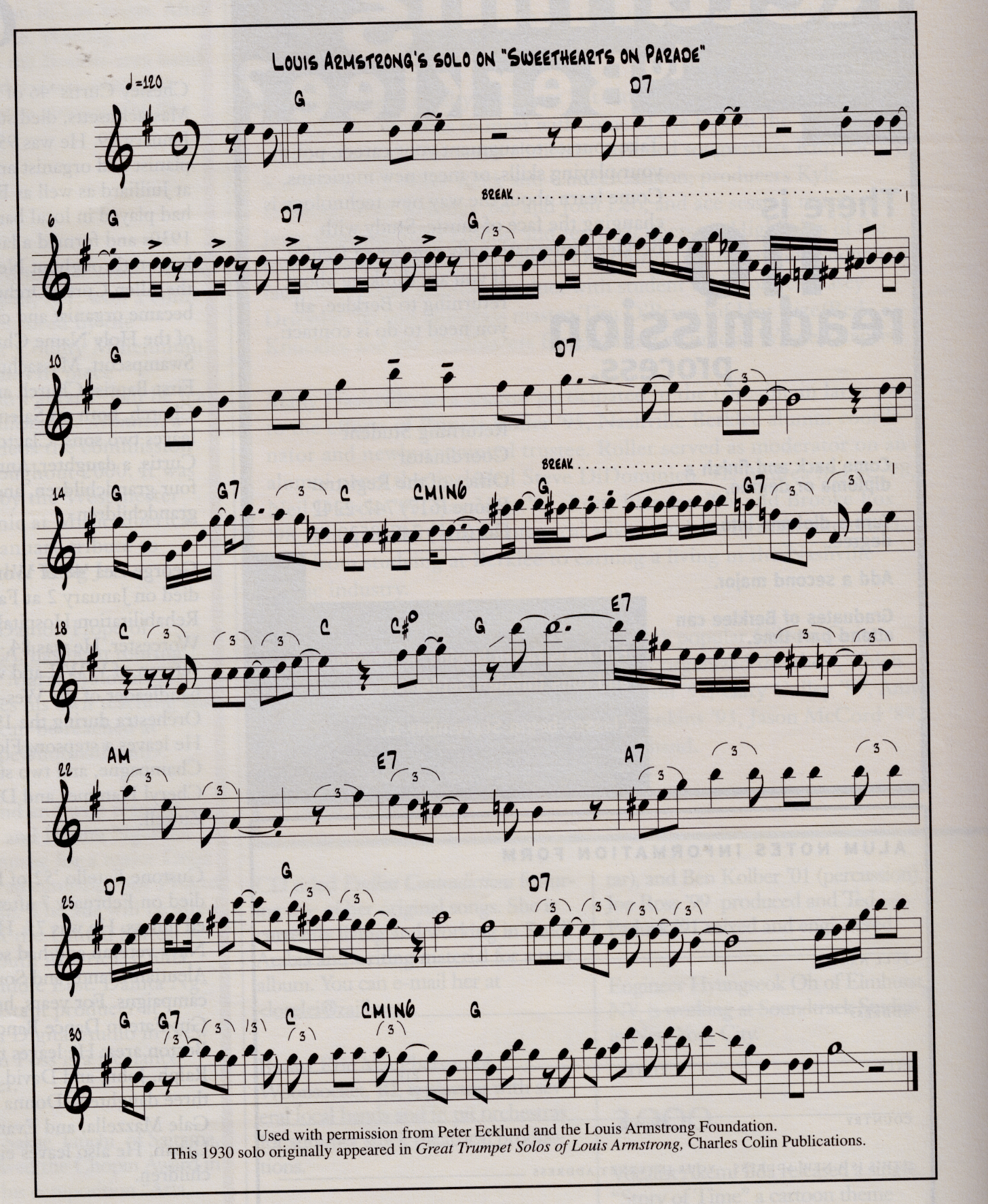Louis Armstrong and the Theory of Relativity

Louis Armstrong's solo on "Sweethearts on Parade"
Time magazine recently named Albert Einstein "Man of the Century." This struck me because I think some musicians would have voted to put Louis Armstrong on the cover. Oddly enough, there are quite a few parallels between these two gentlemen. Both were warm, avuncular figures known and beloved the world over, despite the fact that most people didn't have a deep understanding of the work that they did. It's safe to say that most musicians don't have a deep understanding of why Louis Armstrong should be held in such high regard. They think of him as the smiling, sweating entertainer who sang "Hello Dolly" and other forgettable fare. But Louis was a revolutionary--a smiling, laughing revolutionary.
Scientist Freeman Dyson said that when he first met Nobel Prize-winning physicist Richard Feynman, he thought he was half genius and half buffoon. But after knowing him for a couple of years, Dyson realized that Feynman was all genius and all buffoon. As we know from the case of Mozart, a musician need not be a serious scowling pedant to be a genius of the highest order. Albert Einstein changed the scientific understanding of time, but Louis, in a way that was perhaps more radical, changed the human experience of time.
Louis Armstrong was born August 4, 1901, in New Orleans, according to baptismal records recently discovered by Gary Giddins. But Louis always said he was born July 4, 1900, and in many ways this little white lie is a lot closer to the truth. That's because Louis was solidly a man of the twentieth century, the American century. One of the dominant ideas that has transformed both science and art in this century is that of abstraction: the ability to move from the specific to the general, to remove all unnecessary parts. We think of the painter Mondrian sketching a grove of trees and then gradually, over the course of 20 years, removing all unnecessary elements from that picture of trees until he was left with just two lines. But abstraction doesn't only belong to the visual arts. If you listen to Louis Armstrong sing and play "Lazy River" recorded in 1931, you'll hear the first great spontaneous abstracter at work. After a notably stiff and unswinging rendition of the melody by the saxophones, Louis comes in singing, and boils Hoagy Carmichael's tune down to its essential elements; one or two hip, swinging notes, rhythmically free, and totally abstract. Hoagy reportedly flipped out when he heard this recording, astounded and amazed at Armstrong's transformation of his tune.
Miles Davis once said, "You can't play nothing on trumpet that doesn't come from him, not even modern sh*t." This is true not only for trumpet players, but for everyone. If you listen to the broken rhythms of Louis' solo on "Tight Like That," you can hear the Sonny Rollins of "St. Thomas." If you listen to the polyrhythms of "Hotter Than That" or "When You're Smiling" you can hear, prefigured, the interplay of a great piano trio, like those of Bill Evans or Keith Jarrett. When you listen to the ease with which Louis shifts in and out of double time on "Sweethearts on Parade" [see musical example], you can hear the freedom of Charlie Parker.
We all know the "six degrees of separation" concept. Well, every great musician in jazz is connected to Louis by no more than one or two intermediary figures. For instance, Sonny Rollins's idol was Coleman Hawkins. And Coleman got his mind blown when Louis arrived in New York, when he joined Fletcher Henderson's band while Hawk was in it as a young man. Louis's radical approach caused Hawk to create his own revolution on the saxophone. The best players never copied Louis overtly, but were inspired by him to come up with their own innovations.
One of the most commonly understood ideas contained in Einstein's theory of relativity is that as you approach the speed of light, time slows down, and if you could reach the speed of light, time would stand still. I think Louis understood this in his gut in some way. If you listen to his performance of "Chinatown, My Chinatown" (recorded at that same extraordinary session that produced "Lazy River"), we can hear him put Einstein's famous theorem into musical terms. Again the hysterical saxophones come in--rushing, hectic--it's the 20th century and they can't cope with it. But Louis is completely untroubled by the very fast tempo. In fact, he seems to realize that the faster you go, the more time slows down. When he comes in after the neurotic saxophones, his solo begins with just one beautiful held note, hanging freely above the rhythm section.
We can do what Einstein called a Gedanken experiment (a thought experiment), and imagine Louis's solo all by itself, without the noise and hubbub surrounding him. Heard this way, you can see that Louis was so deeply in touch with the underlying time feeling that he could float above it at will. His solo sounds utterly free, like an aria. Jazz musicians have been absorbing Louis' rhythmic revolution since that day, and now everyone can try to play with that paradoxical quality of deep connection to and freedom from the pulse. Certainly in 1931 Louis Armstrong and Albert Einstein were the only men to be thinking like that.




